Dosha – what does it mean?
What is your Ayurveda Body Type?
What is Kapha, Vata and Pitta?
According to ancient Indian medicine Ayurveda, each of us has a unique mix of three mind and body energies. These three energy forms are referred to as our Dosha.
Based on ancient research the sages of yore minutely studied us, humans, our physical and mental characteristics our habits and eating patterns over centuries. These were then tabulated and the sages drew up a clear chart based on the elements in nature and their parallel energies in our bodies.
Yoga for Sleep – Sleep Poses and Benefits
According to Ayurveda, all humans are a mix of the three energies or Doshas:
- Kapha
- Vata
- Pitta
This very detailed study of humans and their emotions and behaviour can now pretty accurately explain why some people are hyperactive while others have a certain stillness to them?
Why is it that some folks can eat a five-course meal and not put on an ounce while others can gain weight just eating a salad?
1. While Vata is composed of Space and Air, people who fall into this category are lean and energetic.
2. Pitta is made up of Fire and Water, and those in this category are focused sharp, intellectual, precise and discerning.
3. Kapha, on the other hand, is made up of the elements of Earth and Water, those of this energy type is calm, orientated, steady, and consistent.
All of us have one predominant Dosha and some character traits from the rest
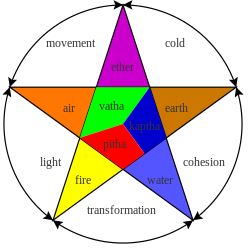
Do you know which body type you are and how by eating right you can control your weight?
According to Ayurvedic medicine when an imbalance occurs in our predominant Dosha we fall sick and are at dis-ease. For instance, if you’re a Pitta type, you may experience heartburn after eating spicy foods. The key to remember is that spicy food is not the best for those with Pitta Dosha. By choosing cooling and foodstuff that are alkalizing, you can support your Dosha.
Yoga for Kids – A Requirement or Necessity?

Here is a detailed summary of Different Body Types according to Doshas:
- Energy snapshot to match the body type
- Followed by words that describe the body type
- Physical Traits
- Emotional Characteristics
- Food Recommended for that body type
Ayurveda Body Type is of 3 Kinds:
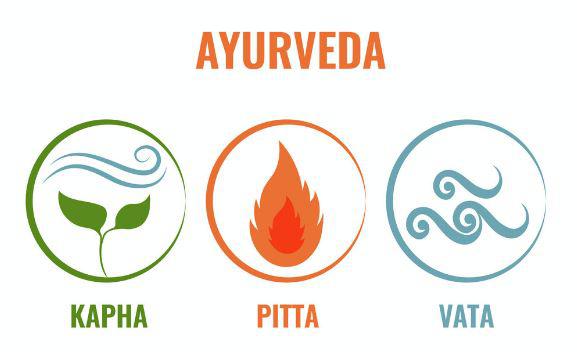
1. Vata is composed of Space and Air
I. Energy Snapshot:
Mind: Creative, quick, imaginative
Body: Thin, light frame
Skin: Dry
Hair: Dry
Appetite: Delicate, spontaneous, often miss meals
Routine: Variable, spontaneous
Temperament: Welcomes new experiences, excitable, friendly, energetic
Conversation Style: Loves to talk
Shopping Style: Buy, buy buy
Stress Response: What did I do wrong? A tendency to blame oneself.
II. Description of Body Type:
Cold, Light, Dry, Irregular, Rough, Moving, Quick, Changeable.
III. Physical Traits:
If you have a predominance of Vata dosha you will usually have a thin, light frame and excellent agility. Your energy comes in bursts and you are likely to experience sudden bouts of fatigue.
Vatas typically have dry skin and hair and cold hands and feet. You will sleep lightly and your digestion can be sensitive. When the Vata dosha becomes imbalanced, it manifests in the body as weight loss, constipation, hypertension, arthritis, weakness, restlessness, and digestive challenges.
The F-word super personal trainer Sapna Khanna uses with effect
IV. Emotional Characteristics:
- As a Vata body type – you love the excitement of new experiences.
- Always quick to anger yet quick to forgive.
- When your Vata is in balance, you are energetic, creative, and flexible.
- Always taking initiative and are a lively conversationalist.
- However, when your Vata is unbalanced, you are prone to worry and often suffer from insomnia. You may also feel overwhelmed or stressed.
- Your response is, “What did I do wrong?”

V. Food Recommended for your body type or dosha type:
Since Vata is drying, cooling and light, you should favour foods that are oily, warming, or heavy.
The best tastes to pacify Vata are sweet, salty, and sour. Minimize foods that are pungent, bitter, or astringent.
Food habits and Kinds – Recommendations:
- Eat larger quantities, but don’t overeat. This helps to balance the lightness of Vata.
- Take sweeteners in moderation. They all help to pacify Vata.
- Fats and oils are beneficial in the digestive system and help reduce Vata.
- Use up to three teaspoons daily of ghee or extra virgin olive oil.
- All low-fat dairy products are recommended. Milk is easier to digest when warm or heated.
Festive Season Fitness – Top 5 Tips
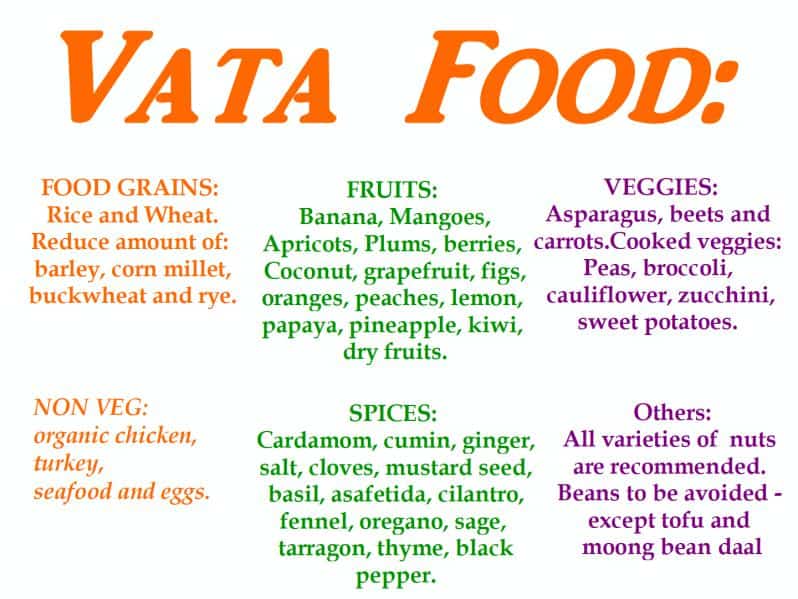 GRAINS:
GRAINS:
Rice and wheat are the best grains for balancing Vata. Reduce the amount of barley, corn, millet, buckwheat, and rye that you consume.
FRUITS:
Favour sweet, heavy fruits such as bananas, avocados, mangoes, apricots, plums, berries, coconut, figs, grapefruit, oranges, lemons, melons, papaya, peaches, pineapples, rhubarb, kiwi, dates, nectarines, and dried fruits.
VEGGIES:
Raw vegetables should be minimized. Favour Asparagus, beets, and carrots. Other vegetables may be taken in moderation if cooked in ghee or extra virgin olive oil, including peas, broccoli, cauliflower, zucchini, and sweet potatoes. Sprouts and cabbage tend to produce gas and should be minimized.
SPICES:
Cardamom, cumin, ginger, cinnamon, salt, cloves, mustard seed, basil, asafetida, cilantro, fennel, oregano, sage, tarragon, thyme, and black pepper.
All varieties of nuts are recommended. Beans can aggravate Vata. Minimize your consumption of beans, with the exception of tofu and mung bean dahl.
NON VEG:
Organic chicken, turkey, seafood, and eggs.
6 Anytime anywhere weight loss tips for you
2. Pitta is composed of Fire and Water
I. Energy Snapshot:
Mind: Sharp, intellectual, direct, precise, discerning
Body: Medium build, warm, muscular
Skin: Sensitive, flush, acne-prone
Hair: Tendency towards early greying or thinning
Appetite: Strong, can eat just about anything, anytime
Routine: Very precise and organized
Temperament: Passionate, driven, courageous, strong sex drive, a good leader
Conversation Style: Speaks to convey a point
Shopping Style: Spends on luxury items
Stress Response: Irritable, tendency to blame others.
II. Description of Body Type:
Hot, Light, Intense, Penetrating, Pungent, Sharp, Acidic
III. Physical Traits:
Pittas are usually of medium size and weight.
Therefore, you sometimes have bright red hair, but baldness or thinning hair is also common in a Pitta.
If you have Pittas, you will have excellent digestion, which sometimes leads you to believe you can eat anything. You have a warm body temperature.
It is found that people with Pittas Body Type, sleep soundly for short periods of time and have a strong sex drive. When in balance, Pittas have a lustrous complexion, perfect digestion, abundant energy, and a strong appetite. However, when out of balance, Pittas may suffer from skin rashes, burning sensations, peptic ulcers, excessive body heat, heartburn, and indigestion.
Yoga or gym – Which is better?
IV. Emotional Characteristics:
Have a Pitta body type?
- You have a powerful intellect and a strong ability to concentrate.
- When you are in balance, you are a good decision maker, teacher, and speaker.
- You are precise, sharp-witted, direct, and often outspoken.
- In case you experience out-of-balance pittas – you can be short-tempered and argumentative.
- When you are overstressed your typical response is, “What did you do wrong?”

V. Food Recommended for your body type or dosha type:
Since an excess of Pitta dosha overheats the mind and body, favour cool foods and liquids. Foods with sweet, bitter, and astringent tastes are best. Reduce foods that are pungent, salty, and sour.
Food habits and its Kinds – Recommendations:
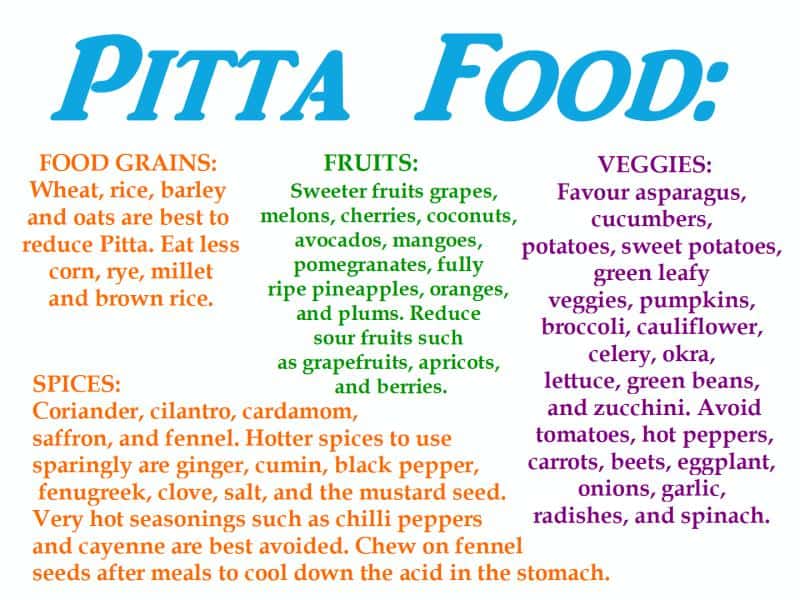
Dairy can help balance the heat of Pitta. This includes milk, butter, and ghee. Sour, fermented products such as yoghurt, sour cream, and cheese should be used sparingly as sour tastes aggravate Pitta.
All sweeteners may be taken in moderation except molasses and honey.
The best oils to pacify Pitta are olive, sunflower, and coconut. Use less of the sesame, almond, and corn oil, which are more heating.
GRAINS:
Wheat, rice, barley, and oats are the best grains to reduce Pitta. Eat less corn, rye, millet, and brown rice.
FRUITS:
Stick to sweeter fruits such as grapes, melons, cherries, coconuts, avocados, mangoes, pomegranates, fully ripe pineapples, oranges, and plums. Reduce sour fruits such as grapefruits, apricots, and berries.
VEGGIES:
The vegetables to favour are asparagus, cucumbers, potatoes, sweet potatoes, green leafy vegetables, pumpkins, broccoli, cauliflower, celery, okra, lettuce, green beans, and zucchini. AVOID tomatoes, hot peppers, carrots, beets, eggplant, onions, garlic, radishes, and spinach.
SPICES:
Coriander, cilantro, cardamom, saffron, and fennel. Hotter spices such as ginger, cumin, black pepper, fenugreek, clove, salt, and the mustard seed should be used sparingly. Very hot seasonings such as chilli peppers and cayenne are best avoided. Chew on fennel seeds after meals to cool down the acid in the stomach.
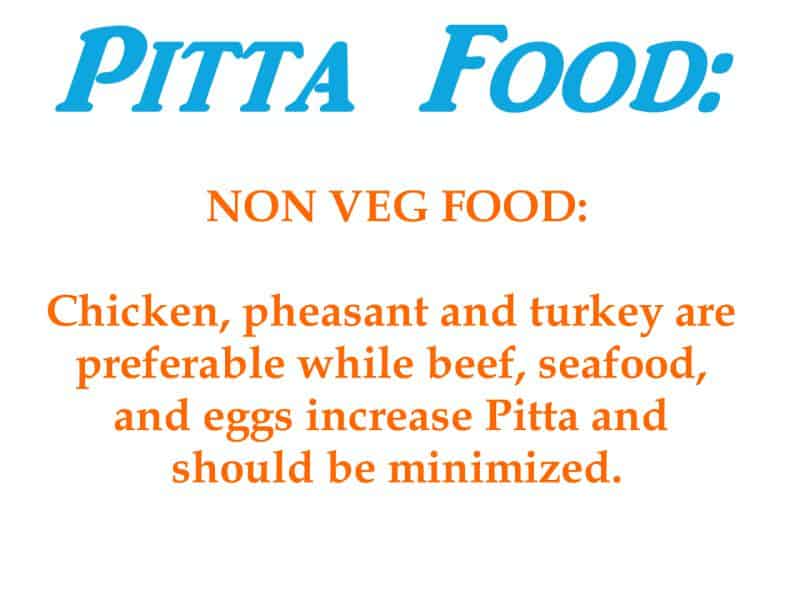
NON VEG:
Chicken, pheasant and turkey are preferable while beef, seafood, and eggs increase Pitta and should be minimized.
3. Kapha is Earth and Water
Energy Snapshot:
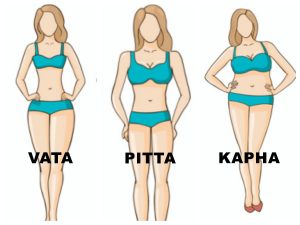
Mind: Detail-orientated, steady, consist
Body: Sturdy, gains weight easily, however, have trouble losing it
Skin: Smooth and oily
Hair: Thick, oily
Appetite: Loves to eat and has a slow digestion
Routine: Methodical and sturdy, resistant to change
Temperament: Thoughtful, forgiving, sweet, patient, loving, content, slow-moving
Conversation Style: Simple yet profound
Shopping Style: Saves
Stress Response: I don’t want to deal with it! Withdrawn.
Description of Body Type:
Heavy, Slow, Steady, Solid, Cold, Soft, Oily
Physical Traits:
Kapha types have a strong build and excellent stamina.
Notice large, soft eyes; smooth, radiant skin; and thick hair and you know you have all Kapha characteristics.
If you experience a sound sleep and have regular digestion – you should think these are signs of a Kapha Body type. Your body could build excess weight. Thus, in such situation allergies will manifest in your body and you will get fluid retention.
In addition, to the above, the moment you are out of balance of Kapaha type – you gain weight, sleep excessively, suffer from asthma, diabetes or depression.
IV. Emotional Characteristics:
- For all of you who have Kapha Dosha body types – you have a strong built and excellent stamina.
- Large, soft eyes; smooth, radiant skin; and thick hair are your important Kapha characteristics giveaways.
- Those of you who are predominantly Kapha sleep soundly and have regular digestion.
- However, when Kapha builds to excess, weight gain, fluid retention, and allergies manifest in the body.
- Moreover, when your Kapha is out of balance, you may become overweight, sleep excessively, and suffer from asthma, diabetes, and depression.
- Your nature is calm, thoughtful, and loving.
- An inherent ability to enjoy life and are comfortable with the routine.
- When you are in balance, you are strong, loyal, patient, steady, and supportive.
- People with an excess of Kapha tend to hold on to things, jobs, and relationships long after they are no longer nourishing or necessary.
- Excess Kapha in the mind manifests as resistance to change and stubbornness.
- In the face of stress, the typical Kapha response is, “I don’t want to deal with it.”

V. Food Recommended for your body type or dosha type:
Kapha Dosha Type food is heavy, oily, and cold, favour foods that are light, dry, or warm. Foods with pungent, bitter, and astringent tastes are most beneficial for pacifying Kapha. Reduce foods with sweet, sour, and salty tastes.
Food habits and its Kinds – Recommendations:
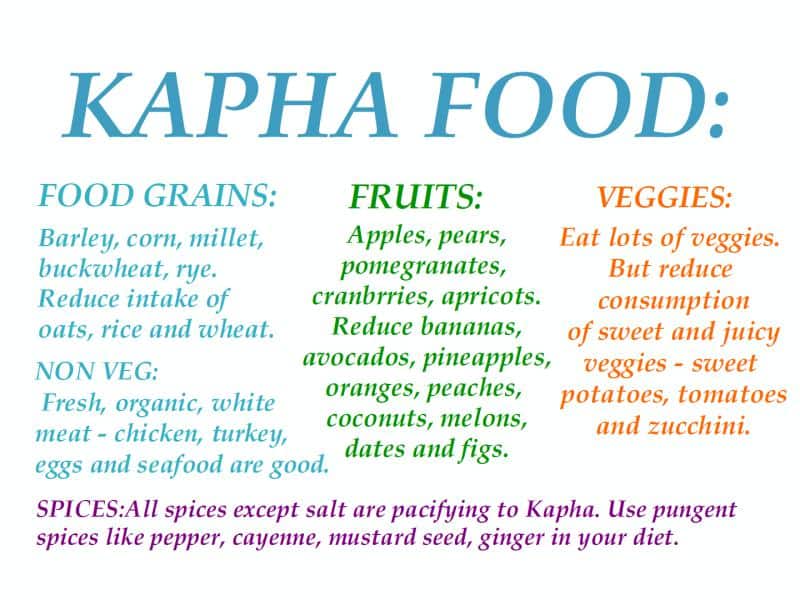
Try a liquid fast one day per week, ingesting only fresh vegetable and fruit juices, and pureed vegetable soup.
Reduce the intake of dairy, which tends to increase Kapha. You can use small amounts of ghee, low-fat milk, and low-fat yoghurt.
Avoid most sweeteners. Honey is one sweetener that can best pacify Kapha. Other sweeteners, however, should be avoided because they increase the Kapha dosha, contributing to problems such as blocked sinuses, allergies, colds, and lethargy. Take a tablespoon or two (but no more) of raw honey every day can help release excess Kapha. Do not cook with honey though.
Drink hot ginger tea with meals to help stimulate slow digestion and sharpen dull taste buds. Drink 2 to 3 cups of ginger tea daily.
GRAINS:
Barley, corn, millet, buckwheat, rye. Reduce intake of oats, rice, and wheat.
FRUITS:
Apples, pears, pomegranates, cranberries, and apricots. Reduce heavier fruits like bananas, avocados, pineapples, oranges, peaches, coconuts, melons, dates, and figs.
VEGGIES:
Eat lots of vegetables. In general, all vegetables are recommended but you should reduce the consumption of sweet and juicy vegetables such as sweet potatoes, tomatoes, and zucchini.
SPICES:
All spices except salt are pacifying to Kapha. Use pungent spices like pepper, cayenne, mustard seed, and ginger freely in your diet.
Eat beans. All beans are good for Kapha types except for soybeans and soybean-based foods such as tofu, which should be eaten in moderation. Reduce the intake of all nuts and seeds. Favour pumpkin seeds and sunflower seeds.
NON VEG:
Fresh, organic white meat chicken, turkey, eggs, and seafood are acceptable.
When we live into the fulfilment of our individual natures and perform every action out of love and in keeping with the universe plan, our lifestyle and dietary decisions too are in sync with our minds and bodies and in balance within our Doshas. In the reverse, we support unhealthy patterns that lead to physical and mental imbalances and that in turn causes disease.
In ancient Ayurvedic medicine, health is defined as the dynamic balance between mind, body, and environment. And helping us create maintain that balance within our bodies is our Doshas.
Read More:
Vayu Mudra – Benefits and How to do it
Do’s and Don’ts of Yoga during Pregnancy – Poses Recommended
What is Mindfulness? Benefits of Mindfulness
How to bring Neck and Shoulder Pain Relief – Stretch, Exercises and Yoga
Best time to do Sirsasana – Can we do Headstand in Evening?
3 Yogic Breathing Exercises for Air Pollution
6 Different Yoga Types and Benefits – Ashtanga, Hatha, Iyengar, Bikram
7 Amazing Health Benefits of Turmeric and Curcumin you never knew






